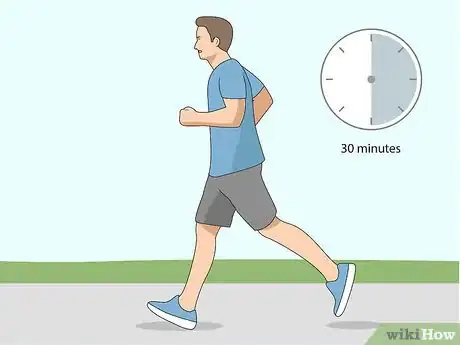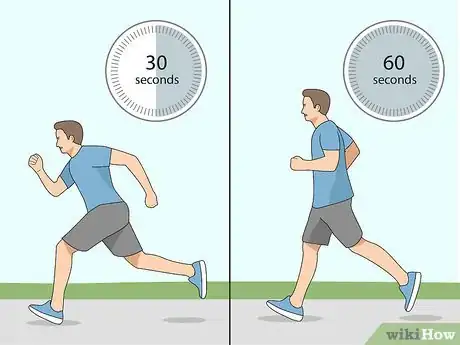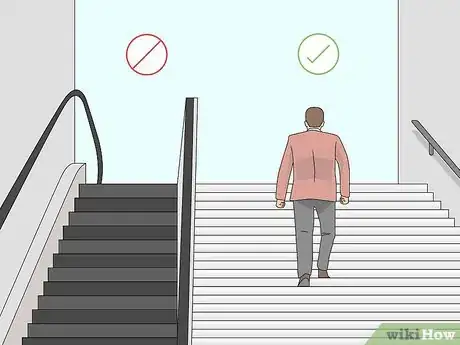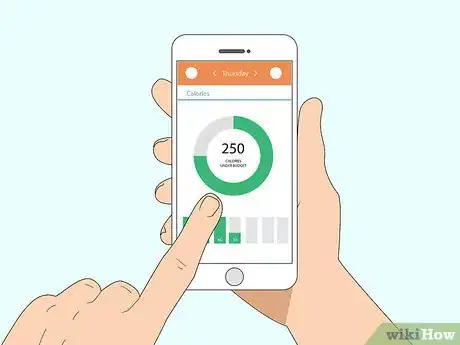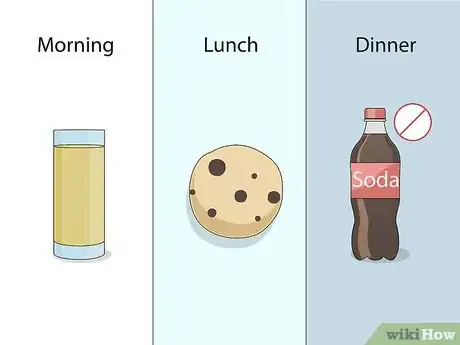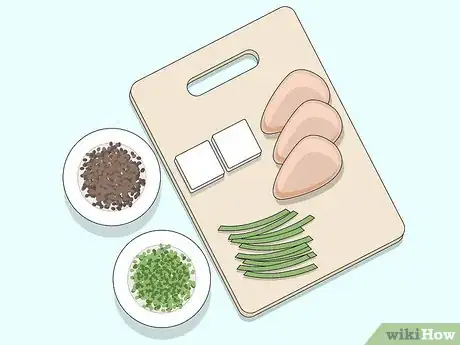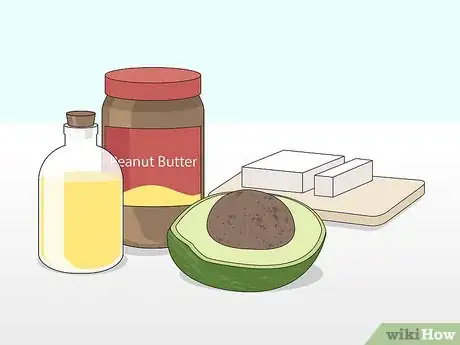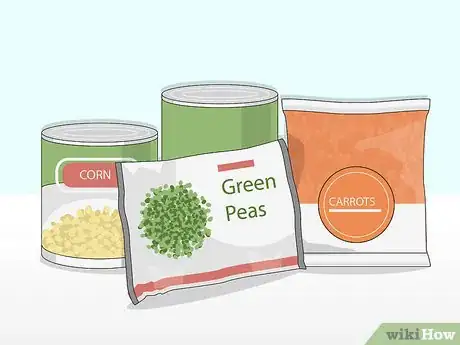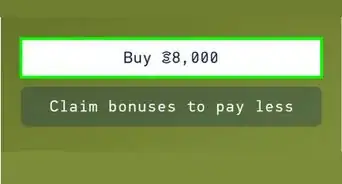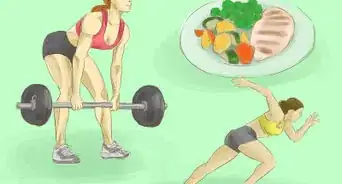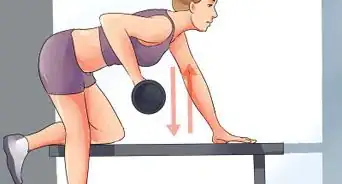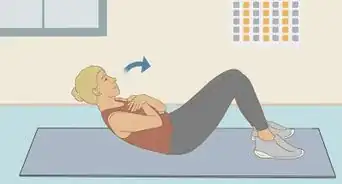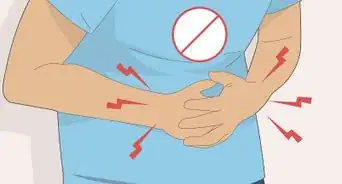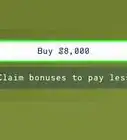This article was medically reviewed by Erik Kramer, DO, MPH. Dr. Erik Kramer is a Board-Certified Primary Care Physician at the University of Colorado. With over 15 years of experience, his clinical interests include obesity and weight management, diabetes care, and preventive care, as well as embracing a holistic approach to primary care. He received his Doctorate in Osteopathic Medicine (D.O.) from the Touro University Nevada College of Osteopathic Medicine and completed his residency at Central Maine Medical Center. Dr. Kramer is a Diplomate of the American Board of Obesity Medicine.
There are 19 references cited in this article, which can be found at the bottom of the page.
This article has been viewed 57,592 times.
Subcutaneous fat sits just under your skin in the hypodermis. It's actually somewhat beneficial to the body, as it provides padding for your skin and doesn't carry the same health risks as visceral fat, which wraps around your organs.[1] However, if you're overweight, losing subcutaneous fat certainly won't hurt, but keep in mind, it's impossible to lose just subcutaneous fat. Instead, you'll work on taking out visceral fat at the same time.
Steps
Getting More Active
-
1Start exercising at least 30 minutes 5 days a week. Get at least 150 minutes of moderate-intensity aerobic exercise, like walking briskly, each week. If you tend to get high-intensity workouts, like running or swimming laps, it’s okay to do 75 minutes total a week.[2]
- Try things like swimming, jogging, running, playing basketball, biking, or playing tennis, just to name a few.
- Exercising will not only help you lose weight, it will also improve your heart health.
-
2Try high-intensity interval training (HIIT) for a more efficient workout. With this type of workout, you go as hard as you can for 20 to 90 seconds, and then you rest for a short period. It can help you lose weight because it revs your metabolism for up to a day.[3]
- It's easy to incorporate HIIT into your workouts. Just work on a 1-to-2 ratio of exercise to rest period. That is, you go as hard as you can for a set amount of time and then rest for double that time.
- For example, if you're biking, bike as hard as you can for 30 seconds then coast for 60 seconds. Keep repeating this process throughout your workout.[4]
Advertisement -
3Add strength training to help build muscle. Strength training is using resistance to increase your muscle mass. You can use your body weight as resistance in exercises like squats, lunges, sit-ups, and pushups. You can also use weights for resistance in exercises like bench presses, shoulder presses, and deadlifts. Always start with low weights and work your way up. For instance, as a beginner, you might start with dumbbells that are 5 pounds (2.3 kg) each.[5]
- Adding muscle will help your body look more defined, even if you don't lose much subcutaneous fat.
- Muscle weighs more than fat, so if you are just judging your health based on weight, it might seem like you aren’t getting healthy even though you are actually losing fat and gaining muscle.
-
4Increase your activity in your day-to-day life. You don't have to hit the gym to get more active. You can burn many calories just by changing a few things in your day. For example, try taking the stairs or parking further out in the parking lot at the grocery store.
- Instead of taking a coffee break at work, take a quick walk around the building.
- Try biking or walking to work instead of taking your car.
-
5Focus on fun calorie-burning activities. If you have fun doing something, you're more likely to keep doing it! Pick things you enjoy that get you moving, such as gardening, dancing around the living room to your favorite music, or taking a walk around a park in the springtime.
- If you have kids, try playing with them. Strike up a soccer match, jump on the trampoline, or play tag.
-
6Grab a buddy to help get you moving. Having someone keep you accountable will help motivate you to move. Get a walking or swimming buddy, for instance. Alternatively, try joining an adult sports league. You could play soccer, softball, or volleyball.
- A dog can also make a good exercise companion. If it likes to go on walks, it won't let you forget in the evening!
Cutting Your Caloric Intake
-
1Track your calories on paper or with a food app. Tracking calories can be a little tedious, but it can also help you realize when you're making choices that aren't as healthy. Food apps make it a little easier because you can look up the food you're eating right on your phone and add it to your food diary.[6]
- Figure out how many calories you typically eat in a day and try to cut that back by up to 500 calories to start with.
- Always talk to a doctor before changing your diet. They can help you decide the best way to cut calories and how many you need to cut.
- For apps, you can try MyFitnessPal, Lose It, or Fooducate, all of which are free.
-
2Measure out your foods to figure out how many calories you're eating. Typically, people tend to underestimate how many calories they're eating. That's why it's important to measure. Look up the serving size for a certain food on your tracking app or online, then measure that much out. Even a little bit extra can add more calories than you'd expect.[7] If it's a packaged food, you can also check out the nutrition label to find the portion size.[8]
- For instance, even a small scoop more of cereal or granola can add 100 calories.
- Learn common portion sizes to make it easier. For instance, a serving of meat is about the size of a deck of cards. A serving of cheese is 4 dice, while a serving of most cereals is about the size of a baseball. For noodles and rice, aim for a portion that's about the size of your fist.[9]
-
3Drink less juice, soda, and smoothies. You may not even realize you're consuming a significant number of calories through your drinks. Start measuring out what you drink to see how much you're drinking. You may be surprised to learn that "little" glass of soda or juice is 200-300 calories. Similarly, fancy coffee drinks may pack more of a caloric punch then you'd expect. It’s better to eat your food, not drink it, so try to avoid smoothies.[10]
- You don't have to cut out sugary drinks altogether. However, make sure you're drinking them in small quantities.
- For other options, try flavored, unsweetened sparkling water, club soda or tap water with added fruit for flavor, or unsweetened tea or coffee.
-
4Cut out 1-2 high-calorie items in your day. You don't have to give up all treats, but it can help to cut things out here and there. For instance, if you have juice in the morning, a cookie at lunch, and soda with dinner, try cutting at least one of those out of your day most of time.[11]
- It can help to swap the item for something else. For instance, instead of juice, try a fruity herbal tea in the morning. Instead of a cookie after your meal, eat some fruit or chew some gum to satisfy your sweet tooth. You could even have a small piece of dark chocolate.
-
5Eat less refined carbohydrates (sugars). Foods like white rice, white bread, and white pasta all contain lots of refined carbs. When you eat refined carbs, your body usually can’t burn through all the energy, and stores it as fat.[12]
- Whole grains like whole-wheat bread and brown rice are much better.
-
6Eat half of your meal when you dine out. When you eat out, the portions tend to be large, and you may overeat. Try splitting something with a friend or family member so you don't consume too much. Plus, you cut down on costs![13]
- You can also split your meal in half right when it comes out. Put one half in a takeout container to take home with you.
-
7Choose smaller plates and dish out individual portions. Opt for a smaller plate when possible. For instance, salad plates tend to hold plenty to fill you up, and you won't take as much food. In addition, leave the pots of food in the kitchen so you won't be as tempted to take seconds.[14]
Eating a Healthy, Filling Diet
-
1Add vegetables to your meals whenever you can. Potatoes don’t count! Vegetables fill you up with fewer calories than other options. When you use them to bulk out your meals, you get the nutrients you need, and you're able to fill up without overloading on calories. Plus, the fiber in vegetables helps keep you fuller for longer.[15]
- For instance, when making scrambled eggs for breakfast, cook strips of bell peppers, mushrooms, or onions in the pan for a few minutes before adding eggs. You could also wilt fresh spinach into the eggs at the end.
- When making wraps or sandwiches for lunch, fill them up halfway with veggies. Try tomatoes, cucumbers, bell peppers, spinach, and onions, just to name a few.
- Bulk up your soups by adding extra vegetables. Most of the time, you won't even notice they're there, particularly if they're cut small enough. For example, add onion, bell pepper, and finely chopped kale to taco soup or sweet potato and onion to chili.
- Try swapping vegetables for some of your carbohydrates. Use zucchini noodles in place of pasta or cauliflower in place of rice or mashed potatoes. Alternatively, just decrease the amount of pasta you fix and add chunks of vegetables instead.
-
2Reach for fruits and vegetables as snacks. While you shouldn't just mindlessly snack between meals, you can grab something if your tummy is grumbling. However, it's best to opt for a piece of fruit or some sliced veggies. They'll fill you up without adding too many calories.[16]
- For example, try an apple, an orange, a banana, or handful of grapes.
- You could also eat half a sliced cucumber, a few slices of tomato, or sliced bell pepper.
-
3Eat low-fat, high-quality proteins. You can get a wide variety of proteins from plant-based sources in your diet, including beans, grains, nuts, seeds, tofu, and vegetables. If you prefer some meat, try chicken or turkey without the skin, fish, and eggs.[17]
- Low-fat dairy is also a good source of protein, including low-fat cheese, skim milk, and yogurt.
- Try to avoid processed meats like hamburgers and red meats like steaks.[18]
-
4Focus on good fats in your diet. Opt for monounsaturated fats and polyunsaturated fats in your diet. They can help you feel fuller, and they are healthier for you than trans fat and saturated fat. Sources of good fats include nuts, peanut butter, avocado, olive oil, olives, canola oil, and sesame oil. You can also try flaxseed, fatty fish, tofu, soymilk, and seeds.[19]
- Monounsaturated fats and polyunsaturated fats are beneficial; they lower blood pressure and reduce your chances of heart disease and stroke, for instance.
- Fatty fish includes tuna, mackerel, salmon, and sardines, to name a few.
-
5Choose whole grains over refined grains most of the time. Whole grains have more fiber, which fills you up. Plus, they offer a more sustained boost of energy, rather than pumping you up so quickly that you crash afterward. Try to eat these with most meals.[20]
- Whole grains include whole wheat pasta, whole wheat bread, flaxseed, quinoa, buckwheat, and bulgur. Oatmeal, brown rice, and barley are also good choices.
-
6Include canned and frozen produce to make your life easier. These options can be just as healthy and nutritious as fresh, sometimes more so. The key is to look for low-sodium options when it comes to vegetables and no-sugar-added versions for fruit.[21]
- Read the labels to see if it has added sugar or salt.
Warnings
- Always talk to your doctor before starting any diet or exercise program. They can ensure that you're picking healthy options for your particular situation.⧼thumbs_response⧽
References
- ↑ https://www.sciencedaily.com/releases/2016/04/160425161349.htm
- ↑ https://www.heart.org/en/healthy-living/fitness/fitness-basics/endurance-exercise-aerobic
- ↑ http://www.yalescientific.org/2011/04/targeted-fat-loss-myth-or-reality/
- ↑ https://www.self.com/story/what-is-high-intensity-interval-training-benefits
- ↑ http://www.yalescientific.org/2011/04/targeted-fat-loss-myth-or-reality/
- ↑ https://www.shape.com/weight-loss/tips-plans/how-cut-calories-lose-weight-safely
- ↑ https://www.shape.com/weight-loss/tips-plans/how-cut-calories-lose-weight-safely
- ↑ https://www.mayoclinic.org/healthy-lifestyle/weight-loss/in-depth/calories/art-20048065
- ↑ https://www.menshealth.com/nutrition/a19546108/portion-size/
- ↑ https://www.cdc.gov/healthyweight/healthy_eating/cutting_calories.html
- ↑ https://www.mayoclinic.org/healthy-lifestyle/weight-loss/in-depth/calories/art-20048065
- ↑ https://cdn1.sph.harvard.edu/wp-content/uploads/sites/30/2013/04/HEPApr2013.jpg
- ↑ https://www.cdc.gov/healthyweight/healthy_eating/portion_size.html
- ↑ https://www.cdc.gov/healthyweight/healthy_eating/portion_size.html
- ↑ https://cdn1.sph.harvard.edu/wp-content/uploads/sites/30/2013/04/HEPApr2013.jpg
- ↑ https://www.shape.com/weight-loss/tips-plans/how-cut-calories-lose-weight-safely
- ↑ https://www.helpguide.org/articles/healthy-eating/choosing-healthy-protein.htm
- ↑ https://cdn1.sph.harvard.edu/wp-content/uploads/sites/30/2013/04/HEPApr2013.jpg
- ↑ https://www.helpguide.org/articles/healthy-eating/choosing-healthy-protein.htm
- ↑ https://www.helpguide.org/articles/healthy-eating/healthy-eating.htm
- ↑ https://www.cdc.gov/healthyweight/healthy_eating/fruits_vegetables.html
